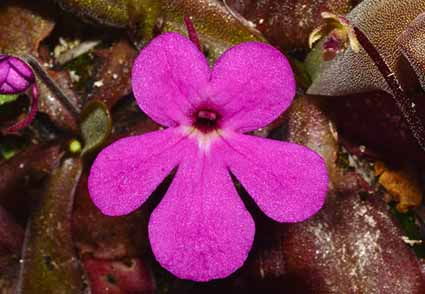Abstract
An undescribed species of Pinguicula (Lentibulariaceae), first collected in 1972 was recently rediscovered in the Arroyo Babarocos canyon, located in the Sierra Obscura region, in the municipality of Uruachi, Chihuahua, Mexico. This plant is described and illustrated as Pinguicula warijia. The taxon is compared with the related species P. oblongiloba and P. zamudioana, and a key to the species of P. section Orcheosanthus of western Mexico is provided, along with photographs, distribution map, and taxonomic discussion.
References
<p align="justify"><span style="color: #000000;"><span style="font-family: Times New Roman, serif;"><span style="font-size: small;">de Candolle, A.P. (1844) Prodromus Systematis Naturalis Regni Vegetabilis 8. Fortin, Masson et Sociorum, Paris, 684 pp. https://doi.org/10.5962/bhl.title.286</span></span></span>
<p align="justify"><span style="color: #000000;"><span style="font-family: Times New Roman, serif;"><span style="font-size: small;">Casper, S.J. (1966) Monographie der Gattung Pinguicula L. Bibliotheca Botanica 127–128: 1–209.</span></span></span>
<p align="justify"><span style="color: #000000;"><span style="font-family: Times New Roman, serif;"><span style="font-size: small;">CONABIO (1998) Climas. Catálogo de metadatos geográficos. Escala 1:1000000. Comisión Nacional para el Conocimiento y Uso de la Biodiversidad (CONABIO). Available from: http://geoportal.conabio.gob.mx/descargas/mapas/imagen/96/clima1mgw (accessed 10 July 2022).</span></span></span>
<p align="justify"><span style="color: #000000;"><span style="font-family: Times New Roman, serif;"><span style="font-size: small;">Hunt, D.R. (1979) Graptopetalum bellum (Moran & Meyrán) D. R. Hunt, comb. nov. Curtis´s Botanical Magazine 182 (4): 130, t. 781.</span></span></span>
<p align="justify"><span style="color: #000000;"><span style="font-family: Times New Roman, serif;"><span style="font-size: small;">INEGI (2014) Conjunto de datos vectorial edafológico. Escala 1:250 000. Serie II. (Continuo Nacional). Aguascalientes, México: Continuo Nacional. Instituto Nacional de Estadística y Geografía. Available from: http://www.conabio.gob.mx/informacion/metadata/gis/eda250s2gw.xml?_httpcache=yes&_xsl=/db/metadata/xsl/fgdc_html.xsl&_indent=no (accessed 10 July 2022).</span></span></span>
<p align="justify"><span style="color: #000000;"><span style="font-family: Times New Roman, serif;"><span style="font-size: small;">IUCN (2022) IUCN Standards and Petitions Committee. Guidelines for Using the IUCN Red List Categories and Criteria, version 15.1. Prepared by the Standards and Petitions Committee. Available from: https://www.iucnredlist.org/documents/RedListGuidelines.pdf (accessed 10 July 2022).</span></span></span>
<p align="justify"><span style="color: #000000;"><span style="font-family: Times New Roman, serif;"><span style="font-size: small;">Juárez-Gutiérrez, H.D., Muñiz-Castro, M.A., Hernández-Rendón, J. & Nuño-Rubio, A.T. (2018) Pinguicula zamudioana (Lentibulariaceae) a new species endemic to western México. Phytotaxa 372 (4): 243–255. https://doi.org/10.11646/phytotaxa.372.4.1</span></span></span>
<p align="justify"><span style="color: #000000;"><span style="font-family: Times New Roman, serif;"><span style="font-size: small;">JSTOR Global Plants (2022) Available from: http://plants.jstor.org. (accessed 10 July 2022).</span></span></span>
<p align="justify"><span style="color: #000000;"><span style="font-family: Times New Roman, serif;"><span style="font-size: small;">Lampard, S., Gluch, O., Robinson, A., Fleischmann, A., Temple, P., McPherson, S., Roccia, A., Partrat, E. & Legendre, L. (2016) Pinguicula of Latin America. Redfern, Dorset, 370 pp.</span></span></span>
<p align="justify"><span style="color: #000000;"><span style="font-family: Times New Roman, serif;"><span style="font-size: small;">Lau, A. (1998) New discoveries and habitats of Pinguicula in México. Proceedings of the Second Conference of the ICPS, Bonn, Germany, pp. 10–11.</span></span></span>
<p align="justify"><span style="color: #000000;"><span style="font-family: Times New Roman, serif;"><span style="font-size: small;">Linnaeus, C. (1753) Species Plantarum 1. Impensis Laurentii Salvii, Holmiae, 560 pp. https://doi.org/10.5962/bhl.title.669</span></span></span>
<p align="justify"><span style="color: #000000;"><span style="font-family: Times New Roman, serif;"><span style="font-size: small;">Lot, A. & Chiang, F. (1986) Manual de herbario. Administración y manejo de colecciones, técnicas de recolección y preparación de ejemplares botánicos. Consejo Nacional de la Flora de México, A.C. México. 142 pp.</span></span></span>
<p align="justify"><span style="color: #000000;"><span style="font-family: Times New Roman, serif;"><span style="font-size: small;">Moran, R. & Meyrán, J. (1974) Tacitus bellus, un nuevo género y especie de Crassulaceae de Chihuahua, México. Cactáceas y Suculentas Mexicanas 19: 75–84.</span></span></span>
<p align="justify"><span style="color: #000000;"><span style="font-family: Times New Roman, serif;"><span style="font-size: small;">Porras, E. (1997) Los warijó de Chihuahua: una etnografía mínima. Ciudad Juarez: Universidad Autónoma, Cuaderno de Trabajo 34, octubre 1997.</span></span></span>
<p align="justify"><span style="color: #000000;"><span style="font-family: Times New Roman, serif;"><span style="font-size: small;">Zamudio, S. (1998) Situación taxonómica de Pinguicula orchidioides DC. (Lentibulariaceae). Acta Botanica Mexicana 42: 7–13. https://doi.org/10.21829/abm42.1998.793</span></span></span>
<p align="justify"><span style="color: #000000;"><span style="font-family: Times New Roman, serif;"><span style="font-size: small;">Zamudio, S., Juárez-Gutiérrez, H.D. & Hernández-Rendón, J. (2018) Cuatro especies nuevas de Pinguicula (Lentibulariaceae) de México. Phytoneuron 2018–14: 1–20.</span></span></span>
<p align="justify"><span style="color: #000000;"><span style="font-family: Times New Roman, serif;"><span style="font-size: small;">Zamudio, S., Salinas-Rodríguez, M.M., Quirino-Olvera, R. & Hernández-Rendón, J. (2019) Pinguicula simulans (Lentibulariaceae), a new species from Nuevo León, Mexico. Phytotaxa 424 (1): 49–55. https://doi.org/10.11646/phytotaxa.424.1.4</span></span></span>
<p align="justify"><span style="color: #000000;"><span style="font-family: Times New Roman, serif;"><span style="font-size: small;">Zamudio, S. & Nevárez-de los Reyes, M. (2020) Una nueva especie de Pinguicula (Lentibulariaceae) de Nuevo León, México. Phytoneuron 2020-28: 1–10.</span></span></span>


